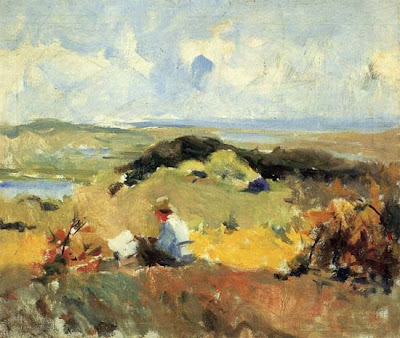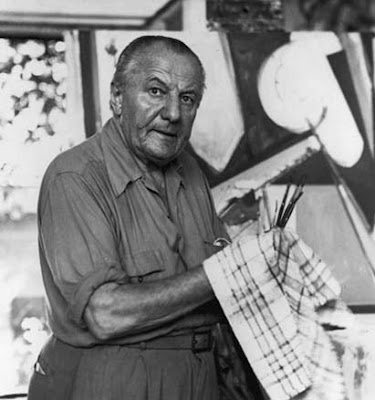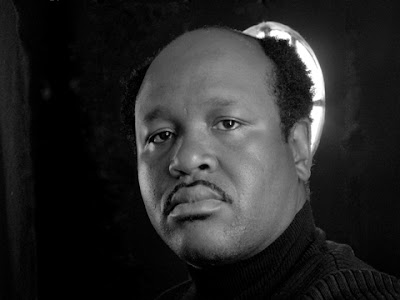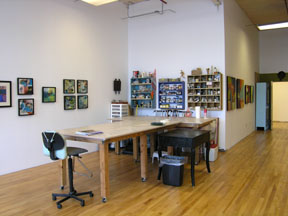 |
| Provincetown with the monument at its back. It's the first thing you'll see as you drive up or arrive by ferry. |
As if I needed to add to my anticipation of going to Provincetown (Ptown) for a week for the encaustic conference and post-con workshops, the other day I read Land's End: A Walk in Provincetown by Michael Cunningham, as recommended by Joanne Mattera on the encaustic conference blog. Although I'd read a couple of other books about Provincetown, I had never read this one. It's a wonderful, lyrical and funny book that captures the spirit and character of that odd place at the end of the Cape Cod hook. Joanne is right: read it before you go and then read it again after you've been there.
 |
| Author Michael Cunningham |
 |
| The book cover with a painting by Provincetown artist and Cunningham friend, John Dowd |
My Ptown History
 |
| "Learned to Laugh," 1997, about 30"x40", collaged xerographic prints in a found frame with dental x-rays. This was the image on the card for my show, which was called "Rest Area." |
 |
| The old PAAM, first established in 1914, this building was purchased in 1919 |
 |
| The new PAAM (note the old building to the right of the picture). This addition/remodel was built in 2005/06. |
Ptown Art History
Anyway, I was thinking that it might be fun to post some images of artists and artworks from Ptown's past for general interest and to give some context for people attending the conference who might not know about Provincetown. So where to begin?
The Three "H"s
Although there have been multitudes of artists who lived, painted, wrote, acted, danced, sang, and performed all manner of artistic activities in Provincetown, in terms of visual art (painting to be more specific), there were three men whose names began with the letter H who were major players: Hawthorne, Hensche and Hofmann. They were teachers who influenced generations of artists in and outside of Provincetown.
 |
| Charles Webster Hawthorne demonstrating painting en plein air, ca 1910, on a pier in Provincetown |
 |
| Hawthorne about 1910 |
Charles Webster Hawthorne (1872-1930) studied with William Merritt Chase, known as the leading proponent of American Impressionism. Hawthorne established the Cape Cod School of Art in Provincetown in 1899. It was the first outdoor school for figure painting and became one of the leading art schools in the U.S. Hawthorne was also one of the founders of PAAM in 1914.
 |
| Hawthorne painting of an artist en plein air |
 |
| Hawthorne's painting of Ptown fishermen (I believe this painting is owned by the town and displayed in Town Hall) |
By 1916, Provincetown was reputed to be the largest art colony in the world! Hawthorne gave weekly instructional lessons and critiques, and his school attracted well-known artists as well as beginners.
Henry Hensche (1901-1992) the second of the H-men, studied with Hawthorne, became his assistant and ultimately carried the torch of his teaching methods and theories. When Hawthorne died suddenly at age 58 in 1930, his school closed. Five years later Hensche reopened the Cape Cod School of Art and carried forward Hawthorne's work by emphasizing Monet's Impressionist tradition of seeing and painting color with light. Hensche referred to himself as a member of the "color realist movement." Both Hawthorne and Hensche taught their students to paint with putty knives and Hensche also added block studies-- "light key, masses, and variations of masses are the essentials of all visual logic." http://www.tfaoi.com/newsm1/n1m288.htm
 |
| Hawthorne portrait of Hensche |
 |
| Hensche in painting demo |
 |
| Hensche portrait of woman in hat |
Hans Hofman (1880-1966) the third pillar of the Ptown teaching trio took an entirely different approach to painting. Born in Bavaria, Hofmann established himself first in Germany and Paris and then moved to the U.S. because of WWII. He retained his European connections but was accepted as an important force in American painting, for example, being included in the Whitney American painting annuals from 1945 on. Hofmann was a player on the world stage of art and spanned art history from Jules Pascin to Picasso, Braque and Matisse through Ashile Gorky, Clement Greenberg and Harold Rosenberg to William Baziotes, Willem deKooning and Bradley Walker Tomlin. He showed throughout Europe and the U.S., had his first New York show at Peggy Guggenheim's gallery, was one of the Ab-Ex Irascibles, represented the U.S. at the 19560 Venice Bienniale along with Philip Guston, Franz Kline and Theordore Roszac and received honors, accolades and attention from all corners.
 |
| Hans Hofmann cleaning his brushes |
A teacher of legendary energy and enthusiasm, Hofmann first established an art school in Munich during WWI and then, forced out of Germany by WWII, brought his school to New York in 1933 after having taught for a while at the Art Students League and other venues. His Provincetown school began as a summer venture in 1935 (note that it was the same year that Hensche reopened the Cape Cod School of Art). From 1939 on, Hofmann spent five months a year in Provincetown and the rest of the year in New York, teaching in each location at his own school. He taught until 1958 when he was 78 and wanted to spend more time on his own work. (official Hans Hoffman website)
 |
| Hofman landscape, 1941 |
 |
| Hofmann "Sanctum Sanctorum", 1965 |
 |
| Hofmann, "Lonely Journey" 1965 |
Hofmann's Push Pull Theory of painting emphasized that two-dimensional space could be created using color and shape rather than depicting objects from a one-point perspective. (Here's a fun experiment from PBS where you can play with color to see Hofmann's theory at work. Be sure to click the brush on the color that you want on the palette first and then on the shape on the blank canvas.) This theory was an important influence on the development of modern art.
Pasted below is a short video that shows Hofmann in the classroom with students and features students talking about the man and his methods. I think this is from the PBS special on Hofmann and is narrated by Robert deNiro. (Ignore the way he pronounces Gloucester as Glowster.)
The Two Painting Camps in Provincetown
Although these three painters/teachers were united by the common first letter of their names, the devotion of their followers to their conflicting theories of painting caused a rift that found a locus in Provincetown. The two schools were known as Regulars (Hawthorne/Henshe) and Modernists (Hofmann and others) and between 1927 and 1937 PAAM held separate annual exhibitions of work for each group after 30 Modernists led by Ross Moffett petitioned for a show of their work. In 1937 PAAM held one show--Regulars on one side of the main gallery, Modernists on the other. From then on they tolerated each other and/or buried their differing views.
Today there are still devoted followers of the Hawthorne/Hensche painting tradition. For example, Hilda Neily, who studied with Hensche for 15 years, runs a gallery together with artist Rob Longley, another Hensche student, and teaches the brand of plein air impressionism learned from Hensche.
 |
| Hilda Neily, "Early Summer Light" |
 |
| Hilda Neily, "Monument View" |
 |
| Robert Longley, "Monument at Night" |
On the other side of the divide, the distinction becomes harder to identify and interpret, but here are a few "Modernists" whose work you may see in the Ptown galleries or the PAAM collection or know from other museums.
 |
| Paul Resika, "Dark Lady", 2001-02. Resika shows at Berta Walker Gallery |
 |
| Resika, "Calabash Beach" 2008, gouache on paper |
 |
| Resika, "Regatta/Three Sails" 2009-10, oil on canvas |
 |
| Ross Moffett, "Life on the Dunes" (unknown date but looks like the '30s) |
 |
| Ross Moffett, "Boatyard" (unknown date) |
 |
| Helen Frankenthaler, "Mountains and Sea", 1952 |
 |
| Haynes Ownby, "Dancing Lobster" 2000 |
 |
| William Freed, "Birds by the Sea", 1959 |
You can see more of these and other artists on the Provincetown Artist Registry here.
Another Major Contributor
The Fine Arts Work Center (FAWC) was established in Provincetown in 1968 by a notable group of artists and writers who intended to make a place for young people to develop their work at an early stage of their careers. Cunningham says they wanted "to restock the town with younger artists and writers the way a forest service restocks a lake with fingerling trout." Residencies run from October 1 to May 1 for ten writing fellows and ten artists from all over the world. During their seven-month stay, fellows get a place to live and work and a small stipend. They must remain in Provincetown throughout the period and focus on their work. Many fellows stay on in Provincetown after their residencies and form a core group of artists and writers with an affinity for the place and its history. Michael Cunningham, for example, first came to Provincetown twenty years ago for a residency at FAWC after two years in the Iowa Writers' Program and never having been east of Chicago. He developed a lifelong love of Provincetown although he makes his main home in New York.
 |
| Fine Arts Workshop (a place that's very hard to get an image of online for some reason) |
This collection of buildings was formerly Days' Lumberyard where many artists rented studios for the summer. An interesting page on iamprovincetown.com gives lots of info about who, when and how much (peanuts) they paid for work spaces.
The old lumber bins were apparently turned into studios for the hardy artists who rented space.
Notable Notables
You can look up these people with a strong Provincetown connection if you have the urge:
Norman Mailer
Jay Crichley
Stanley Kunitz
Pearlene
Meryl Cohn
Tony Vevers
Kate Clinton
Eugene O'Neill
Edna St. Vincent Millay
Ryan Landry
Tennessee Williams
John Waters
Mabel Dodge
Robert Motherwell
Mark Doty
Varla Jean Merman
Robert Pinsky
 |
| Edward Hopper, "Cape Cod Afternoon" |
More, Much More
I hope this piques your curiosity about this fabulous place at the end of the road. Meanwhile, here are a few more images of works that I admire by Provincetown artists.
 |
| Paul Bowen sculpture - wood, tar and found materials |
 |
| Another Bowen wood+tar work |
 |
| Anne Packard, "Cape Marsh" |
 |
| Anne Packard, "Long Point" |
 |
| Anne Packard, "Waiting for the Tide" |
Anne Packard is a beautiful painter. You can click on these and get more of a sense of them. She has a gallery in the gallery district of Commercial Street. Two of her daughters are also painters.
 |
| Cynthia Packard, "Jen" |
 |
| Leslie Packard, "Purple Flowers" |
 |
| Pat deGroot, "Dark Sea and Dazzle" |
 |
| Marian Roth, pinhole camera photograph |
 |
| Polly Burnell (info unknown) |
 |
| Elspeth Halvorsen, "To the Monument," construction, 2007 |
 |
| Nancy Whorf, "Welcome to Provincetown" |
 |
| Nancy Whorf, "Shoveling Snow, " 2007 |
 |
| Sal Del Deo, "Low Tide, East End," 1990 |
 |
| Sal Del Deo, "Winter Solstice," 1982 |
Finally, I'll leave you with an image of the monument the way I began. By the way, if you are looking for something to do in Provincetown and feel the need for a little exercise, climbing to the top of the monument will provide you with that plus a great view from the top. Along the way, you can read the inscriptions on the stones that were purchased by various cities, states, countries, groups and individuals.
One thing that Michael Cunningham mentioned that I hadn't heard before and MUST check out as soon as I arrive, is that the top of the monument bears a distinct resemblance to Donald Duck.
"The Pilgrim Monument is visible almost everywhere, in town and in the wild. If you look at it from the proper angle--obliquely, from any of its four corners--you can see the head of Donald Duck. The top of the tower is his hat, the arches are his eyes, and the crenelations under the arches are his beak. The Donald Duck head is slightly difficult to see, but once you've seen it, you can't look at the Monument and see anything else."
Here's to happy duck hunting!
 |
| Provincetown monument at night |























